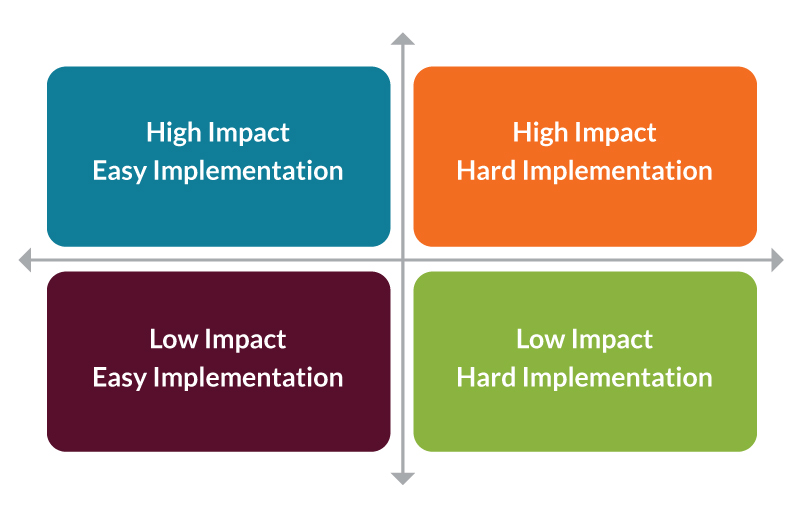Brainstorming ideas with a team can be a rewarding way to generate new ideas and stimulate energy for the entire group. On the flip side, if not done productively, it also can be a colossal waste of time and drain their energy. What’s the difference in outcome? Great preparation and facilitation! Here are six steps to help you get there.
At Corporate Path Leadership, we have both facilitated brainstorming sessions, and been on the participant side for years with different teams. Here is our simple framework for making your next brainstorming session a success:
Step #1: Make Sure the Leader Specifically Outlines the Issue That Needs to be Addressed
The key phrase here is “be specific.” The leader should identify clearly what they envision the problem or issue to be that needs new ideas from the team. This needs to be written down and used for the initial kick-off of the brainstorming session. In addition, the leader should be able to clearly articulate what success would look or feel like once the session is wrapped up.
Step #2: The Leader Should Kick Things Off, and Then Depart
Have the leader come to the brainstorming session, but only for the first 10-15 minutes to start the meeting and clearly convey to the team what the goals of the brainstorming activity look like, including a detailed description of the problem that needs brainstorming ideas (using the notes from Step One above). The leader should stick around to answer any questions from the team and then depart. Why? Because the leader is more likely to favor (even if subconsciously) certain ideas or certain team members and exert influence over the ideas before they have a chance to fully surface.
Step #3: Let the Ideas Flow
The team will have an allotted amount of time to create ideas. Each team member should create a minimum of two to three ideas, putting each individual idea on a post-it note. Once the ideas are initially created, the team members will share them with each other and determine where some similar ideas can be combined. When combining ideas, create a new post-it note that combines the multiple ideas into one clear action. This marks the initial idea generation phase. It’s important to note that no ideas should be eliminated yet. It may be helpful to assign a person from the team to take notes as the team talks through ideas to be sure no ideas are missed.
Step #4: Map Out the Ideas
After the ideas are captured, the team will spend no more than 15 minutes mapping them out on a four-quadrant grid that conveys the following:
While it’s important to spend a little bit of time thinking through what it might entail to get each idea across the finish line, don’t spend a lot of time on logistics and details. Giving a time limit will help keep any one idea taking up too much time to map. The goal is to provide a team view of how the ideas would stack up to each other from an execution-priority lens. Once complete, the team should take a picture of the completed board, and then make a second copy of the ideas on post it notes, leaving that second copy on the table for the leader.
Step #5: Now It Is the Leader’s Turn to Get to Work
The team should leave the room, leaving the leader alone to scan the ideas and how the team prioritized them from an impact and implementation difficulty perspective. The leader can move the post-it notes around on the same grid, giving his/her perspective on any differences in placement. Next, the leader takes the second set of identical ideas (on the post-it notes left by the team) and chooses the three ideas that he/she thinks should be put in action immediately. It may be helpful to assign a person to take notes as the leader talks through their input for use later when the leader goes through their thoughts with the team.
It is important here to only choose two or three ideas for implementation, to make sure they will be completed. If needed, the team leader can come back for more implementation ideas on the two or three items selected. The leader should also call out any ideas that they know cannot ever be addressed, so he/she can talk about them (and why they will remain off the table) with the entire group.
Step #6: Time to Reconvene
The team reconvenes with the leader and reviews the final top two or three priorities from the leader. The leader should explain why each idea will be implemented, and why select ideas won’t be implemented. This is where deep conversations can take place. The leader can acknowledge all of the great ideas generated and comment on why some ideas might be harder or easier to implement than the team originally thought — as well as why some ideas could have a smaller or larger impact.
Spending a few hours up front can truly make a big difference in the overall success of your next brainstorming session!! We challenge all of our readers to try out this format the next time you need a brainstorming session. It is a great way to quickly get ideas surfaced without initial leadership resistance. Plus, it provides leaders a quick way to scan and evaluate anonymous team ideas that can help improve an existing challenge or opportunity.
Contact Us Today
We make it easy to jump start success. Simply contact us and share your current team challenge or need, and we’ll respond with program ideas to innovate your team performance.


